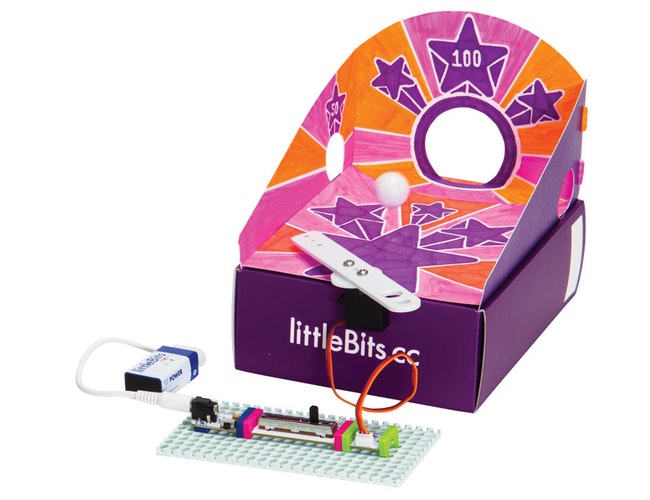Carnival Games Challenge Part 1
Design an interactive game!

Inspire
Career Exploration
Explore these two women who have made significant contributions to STEM fields. Please take a few minutes to read their stories in the postcards below and think about the following:
- Can you see yourself in her job?
- Are you interested to learn more about her job?
- What inspires you about this role model?
Download Women in STEM postcards here:
TERRY WINSTON EDITH CLARKE
INSPIRE IN ACTION
Students will now have a chance to describe and draw themselves in their future STEM career.
-
Please print the My Future Self Worksheet and complete the activity.
INSPIRATIONAL INVENTION VIDEOS OF THE DAY
These videos show examples of interactive games invented with littleBits and other materials. Take a look!
Invent a game that puts a new spin on an old arcade favorite: the Pinball Machine. Use the slide dimmer to bounce the ball all over this invention. But watch out, the ball will bounce and bump all over the box like it's out of control!
This project is created with littleBits by BONEVET makers to show the glorious moment when Majlinda Kelmendi won the gold medal at the Rio Olympics Women's Judo Final. The game can be played by two players.
Marble Mission: an arcade game made with littleBits!
Arcade game made with littleBits: you can make targets with prizes behind them that are released when hit by a coin.
littleBits Wrestling Game
Tech Table Tennis
Create
Carnival Games Challenge
Design an interactive game!


Brainstorm:

-
Create a list of carnival games you would like to create.
-
Sketch out or write down three ideas.
Choose an idea:

Choose one idea to bring to life.
-
What are the constraints?
-
Constraints are the limits and requirements that need to be considered in the invention process.
-
Examples include time, materials, weight. Detail any constraints that you may need to keep in mind as you work.
-
-
What are the criteria for success?
-
What is the number-one goal for the invention? What qualities are important for the invention to have?
-
How will players know when you win or lose the game? What are the rules players should follow?
-
-
If you are designing a brand new game, consider some things:
-
COMPONENTS: Whether it’s the players that make the game, little wooden pawns, or extraterrestrial obstacles, your game needs items.
-
PLAYERS: Is it an individual or multi-player game?
-
SPACE: Well, it all needs to happens somewhere, right?
-
MECHANICS: The actions that you take in the game. Think of verbs like jumping, pushing, swinging!
-
GOALS: Make your game have multiple goals that allow your players to make interesting choices.
-
STRATEGY: Even if you are making a very simple game, make sure that it allows for some strategy so that, if played again, the game will not give the same outcomes. Bottom line: If the same person is winning over and over, something is wrong.
-
SURPRISES: You might not be the surprise type, but a game is no fun without some unexpected moments.
-
Explore your Bits and Materials:

-
Look through your available Bits and materials to see how they could (or couldn’t) help solve their problem.
-
For example, how could a servo trigger a proximity sensor?
-
How could a buzzer give feedback about the game? How could other materials (e.g. books, cardboard, cups) serve as triggers or targets?
-
If you get stuck, try snapping a Bit into a circuit or read through the DCI STEM STEM Kit Bit Index
-
Sketch Out Your Idea:

-
Create a drawing(s) of your first prototype, labeling Bits and any important features. A description of how the prototype is supposed to work can be included.
-
Describe the #1 goal for the invention
-
What do you want your invention to look like?
*SAVE THIS SKETCH FOR REFERENCE*
Create your First Prototype:

-
A prototype is a simple model that lets you test out your idea!
-
This is a time for you to dig into the Bits and materials and start to bring their ideas to life. Think big!
-
Use your sketch as inspiration for your first prototype.
Don’t worry about getting everything right on the first try! The important thing is to just get started and experiment.
Building a physical model of your idea makes it easier to share with others and collect feedback on your design.
Make a plan for next session
-
In the next session, you will test, and improve your carnival game. You will also make a poster of how it works and the rules for winning.
-
Are there any special materials you would like to use?
-
Make a plan to gather these materials for next session if you don’t have them in this session!
MOVE ON TO THE NEXT PAGE HERE!
Resources
Inspirational Links:
Sample littleBits game inventions
littleBits Marble Mission Arcade Game
Helpful Links:


